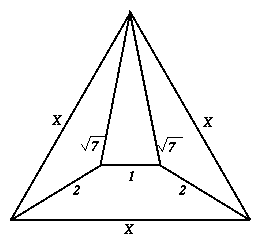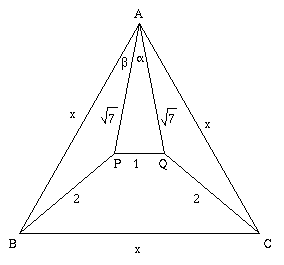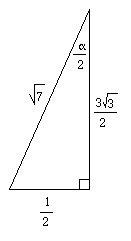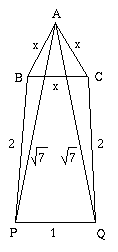Xtra
Find the sides of an equilateral triangle ABC where a trapezium
BCPQ is drawn with BP=CQ=2 , PQ=1 and AP+AQ=sqrt7 . Note: there are
2 possible interpretations.
Problem
What is the value of $X$ in the equilateral triangle
below?
In how many different ways can you find this out?
Image

Getting Started
What are the ratios of the sides of a 30, 60, 90 degree
triangle?
Student Solutions
Two solutions to this problem have been forthcoming from different students at the same school - Madras College. Thank you to Mike and Euan who used lots of trigonometry as well as to Thom who likewise resorted to double angles and the cosine rule and reduced the problem to solving a quadratic equation. Thom was also able to show the significance of the two roots.
Image

Image

Image

A solution which just needs Pythagoras's Theorem was sent in by Ewan from King Edward VII School, Sheffield. See if you can work it out from the diagram below, then reveal the hidden text to check your answer.
Image

The diagram shows the median AU at point A cutting the triangle in half. The length AU is in two parts, $y$ and $z$. Since the triangle is equilateral, $y+z=\frac{\sqrt 3}{2}x$. (You may like to prove this e.g. by trigonometry) To work out $y$ use Pythagoras's Theorem:
\begin{align}
y^2+\left(\frac{1}{2}\right)^2 &=\left(\sqrt 7\right)^2 \\
y^2 &= \frac{27}{4} \\
y &= \frac{3\sqrt 3}{2}
\end{align}
and use $y+z=\frac{\sqrt 3}{2}x$ to give $z = (x-3)\frac{\sqrt 3}{2}$.
Then more Pythagoras's Theorem and our values found above give
\begin{align}
z^2+\left(\frac{x}{2} - \frac{1}{2}\right)^2 &=2^2 \\
\frac{3(x-3)^2}{4} + \frac{(x-1)^2}{4} = 4
\end{align}
which simplifies to get the same equation as Thom and the others: $x^2 -5x + 3 = 0$.
What a simple solution, Well done!
\begin{align}
y^2+\left(\frac{1}{2}\right)^2 &=\left(\sqrt 7\right)^2 \\
y^2 &= \frac{27}{4} \\
y &= \frac{3\sqrt 3}{2}
\end{align}
and use $y+z=\frac{\sqrt 3}{2}x$ to give $z = (x-3)\frac{\sqrt 3}{2}$.
Then more Pythagoras's Theorem and our values found above give
\begin{align}
z^2+\left(\frac{x}{2} - \frac{1}{2}\right)^2 &=2^2 \\
\frac{3(x-3)^2}{4} + \frac{(x-1)^2}{4} = 4
\end{align}
which simplifies to get the same equation as Thom and the others: $x^2 -5x + 3 = 0$.
What a simple solution, Well done!
Teachers' Resources
Why do this problem?
There are several different ways of solving this problem. It is a good example to bring home the point that, to be an expert problem solver, and to understand a piece of mathematics, it is not enough to find an answer. One should ask oneself "Have I used the best method?". This problem can be solved using trig formulae and the cosine rule but it can be solved more straightforwardly using only Pythagoras theorem.Possible approach
Challenge the class to find different methods of solution.Key question
How do we interpret the two solutions?Is the diagram correct for both solutions?
